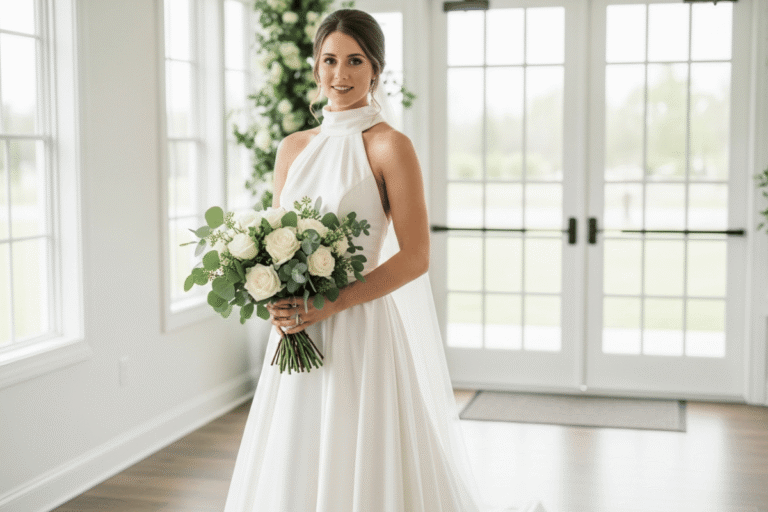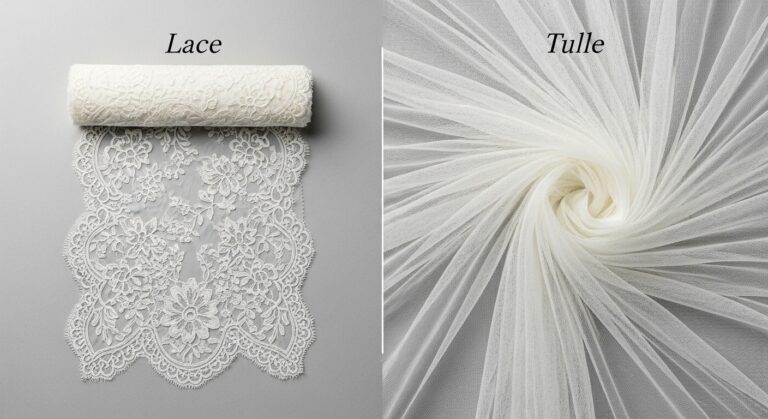Petite Wedding Dresses – Finding the Perfect Fit for Short Brides
Every bride desires a wedding dress that perfectly fits and flatters her unique physique, making her feel confident and beautiful. Petite brides, however, frequently encounter challenges in finding gowns that suit their smaller frames without overwhelming them. This guide aims to simplify the selection process, helping petite brides choose a dress that complements their body shape, personal style, and ensures comfort throughout their special day.
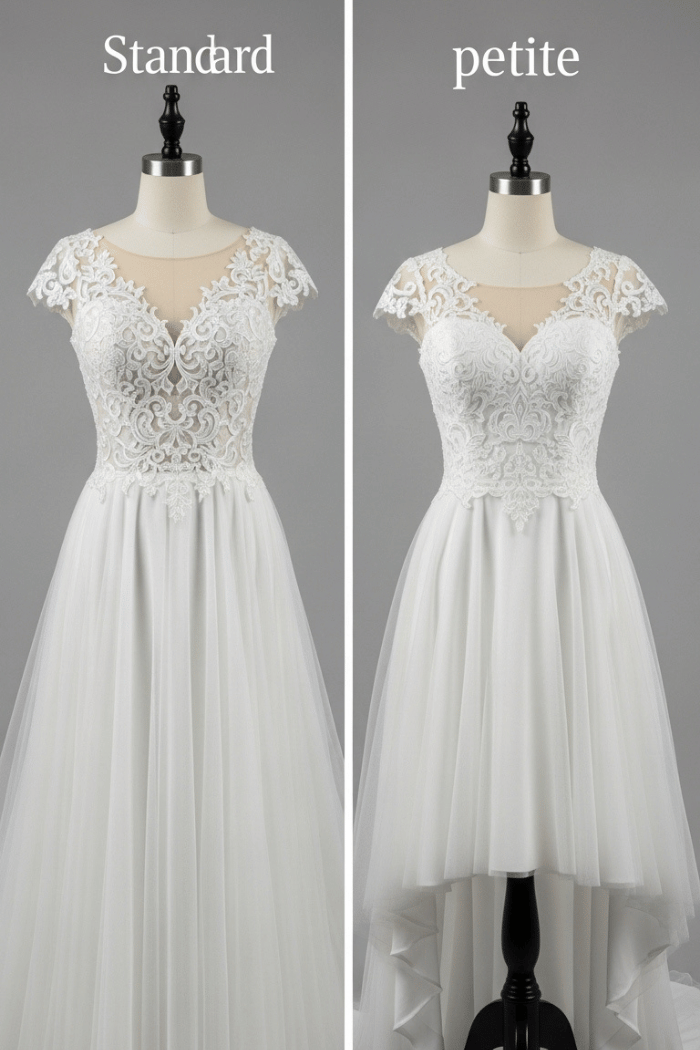
Table of Contents
- What Defines a “Petite” Wedding Dress?
- Best Silhouettes and Styles for Petite Brides
- Petite Wedding Dresses for Short Brides
- Tips to Look Taller in Your Wedding Dress
- Petite Summer Wedding Dresses
- Right Dress for Petite Brides with a Small Bust
- Petite Lace Wedding Dresses
- Long Sleeve Petite Wedding Dresses
- Petite Plus-Size Wedding Dresses
- Wedding Dresses for Petite Brides with an Hourglass Figure
- Conclusion
- People Ask Questions
What Defines a “Petite” Wedding Dress?
In fashion, “petite” refers to a height range typically for individuals under 5’4″ (163 cm). It does not necessarily indicate a small body size or slender physique. Petite wedding dresses differ from standard gowns by featuring adjusted proportions in critical areas. According to a 2022 study by the Fashion Institute of Technology, these adjustments include shorter sleeves, a recalibrated bust line, higher waist placement, narrower hips, and reduced overall length. This proportional scaling prevents excess fabric from engulfing a smaller frame.
Petite sizing encompasses a wide range of body types; curvy or plus-size brides also identify as petite based on their height. Most off-the-rack wedding dresses do not specifically account for petite proportions. Therefore, many petite brides anticipate custom alterations to achieve a flawless fit. Professional bridal seamstresses commonly modify gown length, sleeve width, and bodice structure. This ensures a tailored appearance and optimal comfort.
Leading bridal designers, such as Morilee New York, address these needs. Their collections offer an extensive size range, from 0–28 and 16W–32W in their Julietta collection. Many Morilee gowns are also available in multiple lengths—55”, 58”, and 61”—accommodating both petite and taller brides.
Best Silhouettes and Styles for Petite Brides
Achieving visual elongation is a primary goal for many petite brides. Specific silhouettes effectively create this desired effect.
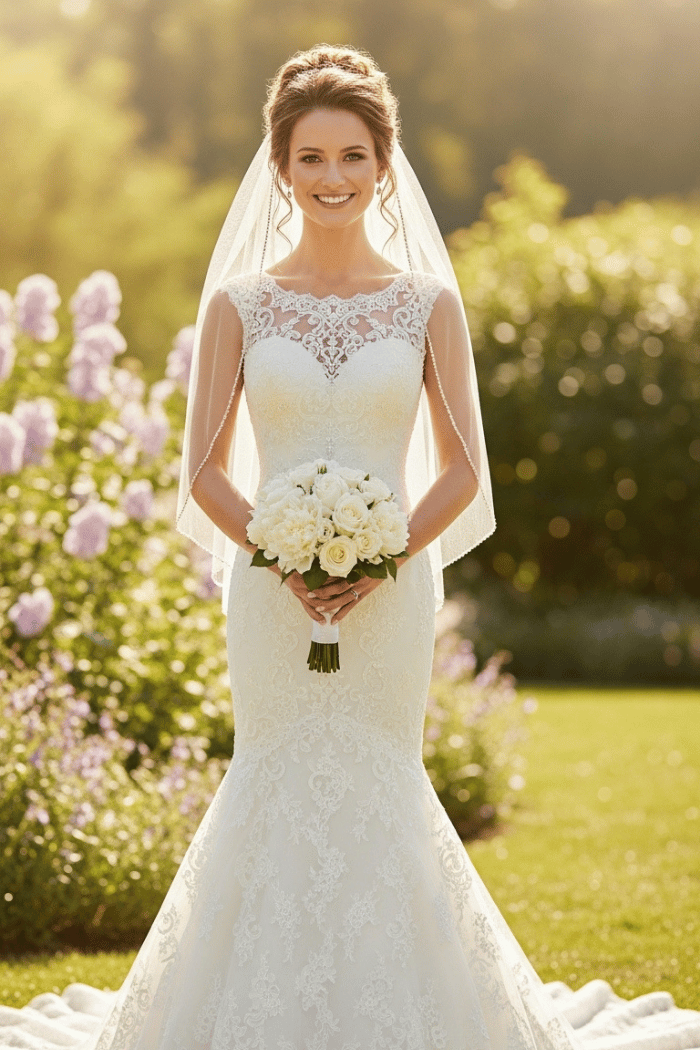
Mermaid Wedding Dresses
The mermaid silhouette excels at accentuating the hips and creating curves. Its dropped skirt design significantly contributes to visual length. According to a 2018 study on fashion design principles published in the Journal of Apparel Design and Technology, the mermaid’s elongated bodice and flared hem draw the eye downwards, enhancing the body’s vertical line. This design particularly suits narrow or athletic builds.
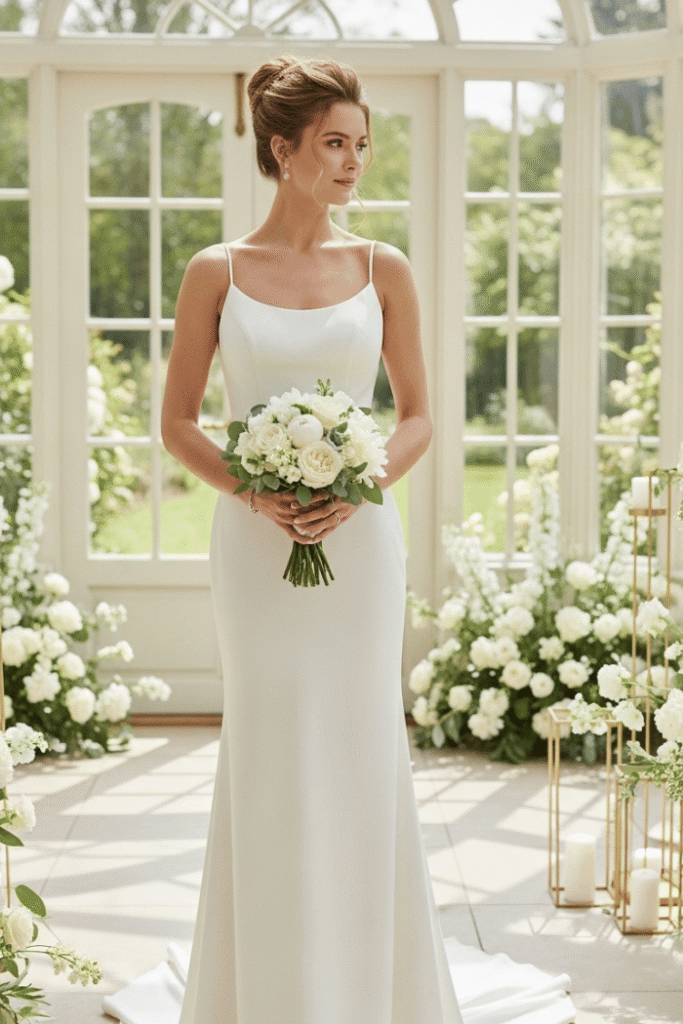
Sheath/Column Dresses
Sheath or column dresses offer a streamlined silhouette. They gracefully skim the body without excessive volume. This design elongates the frame without overwhelming a petite stature. These gowns provide a clean, uninterrupted line, contributing to a taller appearance.
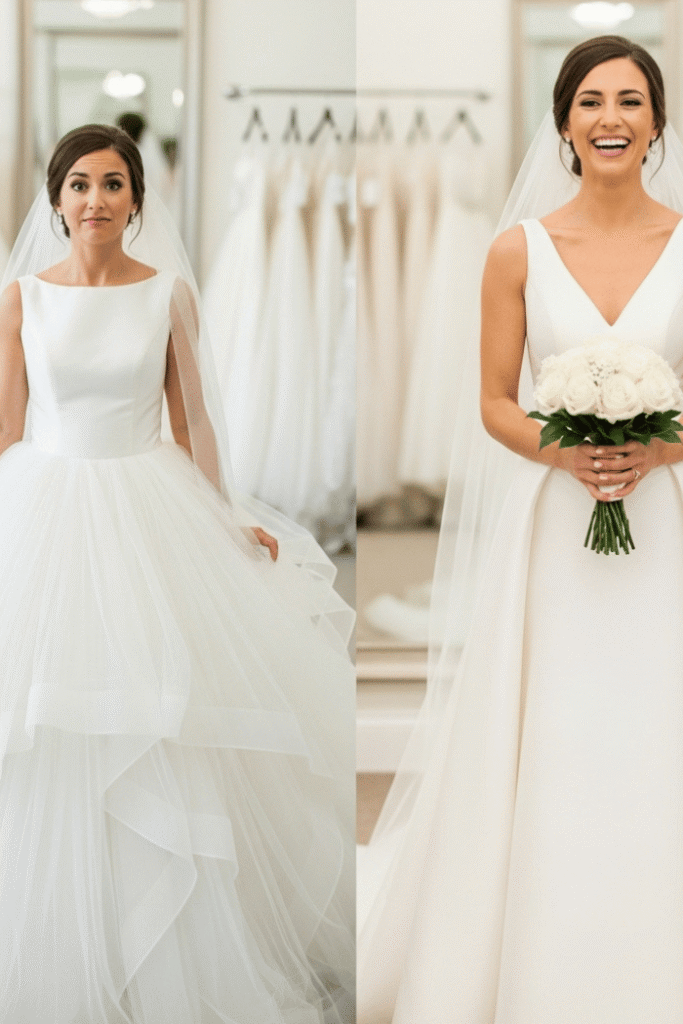
Avoiding Full Ball Gowns
Petite brides often find full ball gowns overwhelming. The abundant fabric in such styles can visually shorten the frame. It creates horizontal mass rather than emphasizing vertical flow.
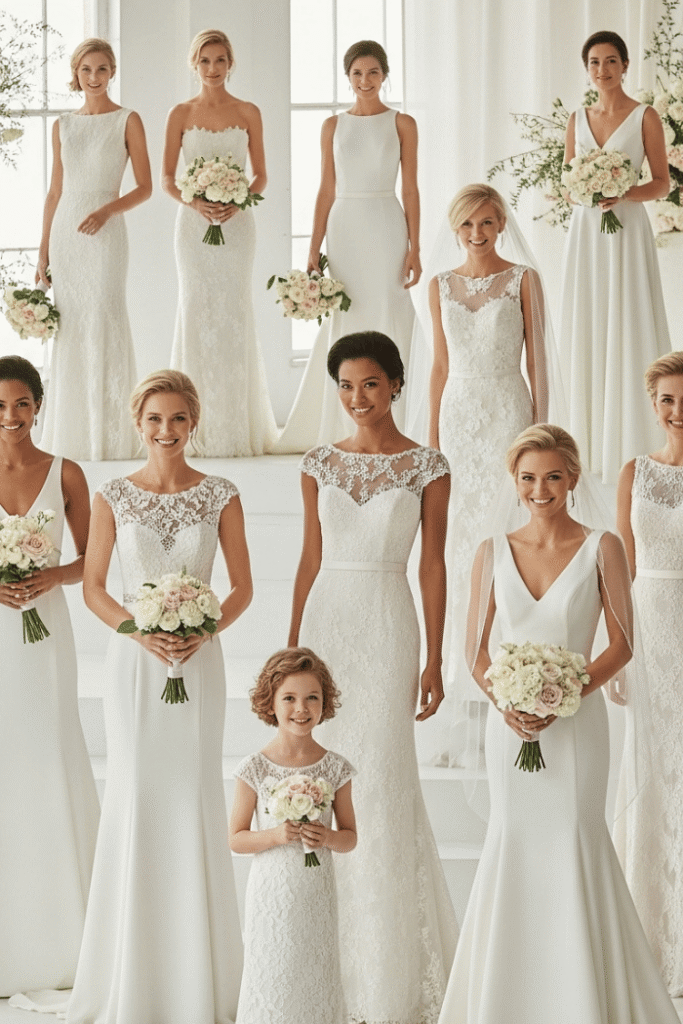
Petite Wedding Dresses for Short Brides
Specific dress styles cater directly to the needs of short brides, offering unique aesthetic and practical advantages.
Short Wedding Dresses
Mini dresses provide an excellent option for petite brides seeking to avoid being enveloped by fabric. These contemporary styles celebrate the bride’s proportions. They offer a unique and unexpected bridal look. The Virtue Wedding Dress, for instance, offers a versatile design with a detachable overskirt.
Skirt Slits
Skirt slits effectively create vertical lines within a gown’s design, visually elongating the legs. This feature breaks the expanse of fabric on a longer gown. For fitted styles, the Eleni Wedding Dress, a satin gown with a thigh-high slit, exemplifies this elongating effect.
Romantic Full Skirt Options
Even fuller skirts can flatter petite brides with strategic design. The Filippa Wedding Dress, an A-line gown, features a skirt slit and embellishments. These elements work in concert with a plunging neckline to elongate the figure, allowing for a romantic aesthetic without overwhelming the frame.
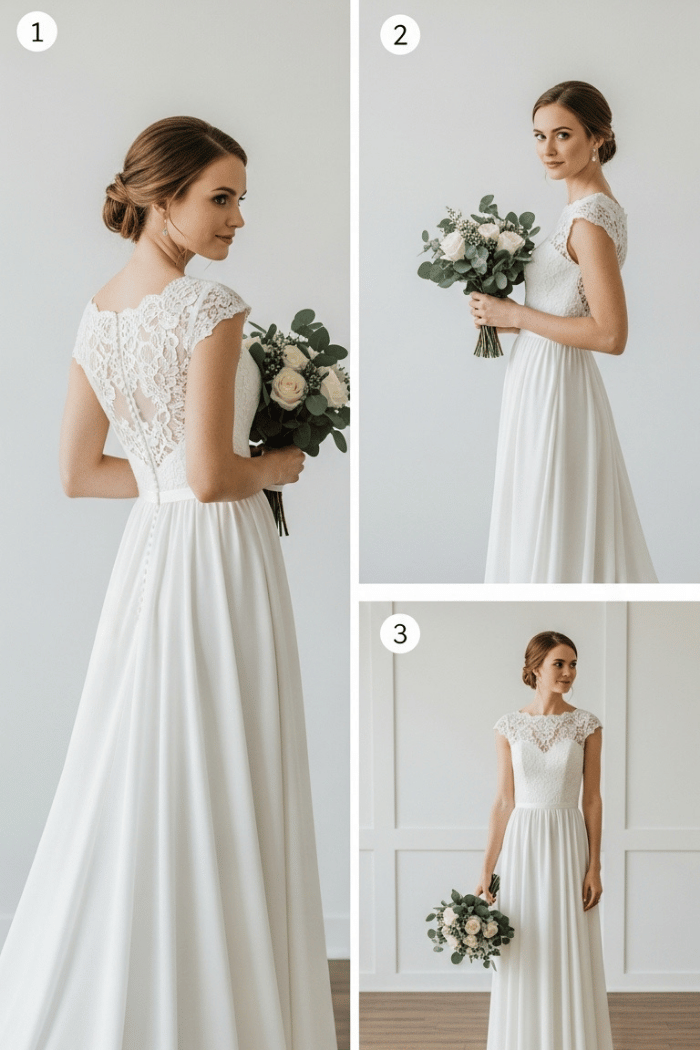
Tips to Look Taller in Your Wedding Dress
Several design elements within a wedding dress can contribute to a visually taller appearance for petite brides.
High-Waisted/Empire Bodices
High-waisted or empire bodices sit just below the bust. This placement visually lengthens the legs while seemingly shortening the torso. This alteration in proportion creates a significant illusion of height.
Sheath or Column Silhouettes
As previously noted, sheath or column silhouettes provide straight, uninterrupted lines along the body. This streamlined design inherently elongates the figure.
Plunging V-necklines
Plunging V-necklines create a strong vertical line that draws the eye downwards. This design is particularly effective for brides with smaller busts, as it adds visual length and contributes to a taller illusion without excessive volume. The Kalliope Wedding Dress, with its empire bodice and sheath silhouette, along with the Euphemia and Fiora Wedding Dresses, exemplify these elongating features.
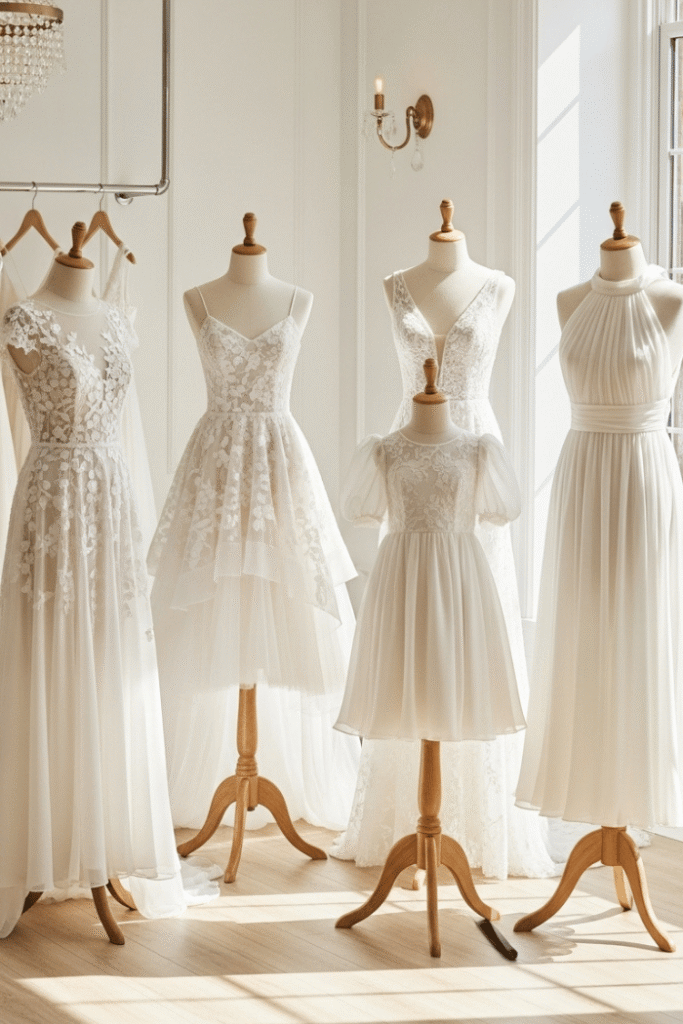
Petite Summer Wedding Dresses
Summer weddings, characterized by bright weather, often inspire specific dress choices. For petite brides, lightweight, airy fabrics are paramount. Chiffon, for example, offers comfort in warm climates and drapes elegantly without overwhelming a smaller frame. Boho or flowing silhouettes, commonly seen in summer wedding attire, can also suit petite brides when designed with slim A-line cuts. The Sevren Wedding Dress provides an example of a boho gown with a modified drop waist and a flowing chiffon skirt, designed to flatter a petite figure.
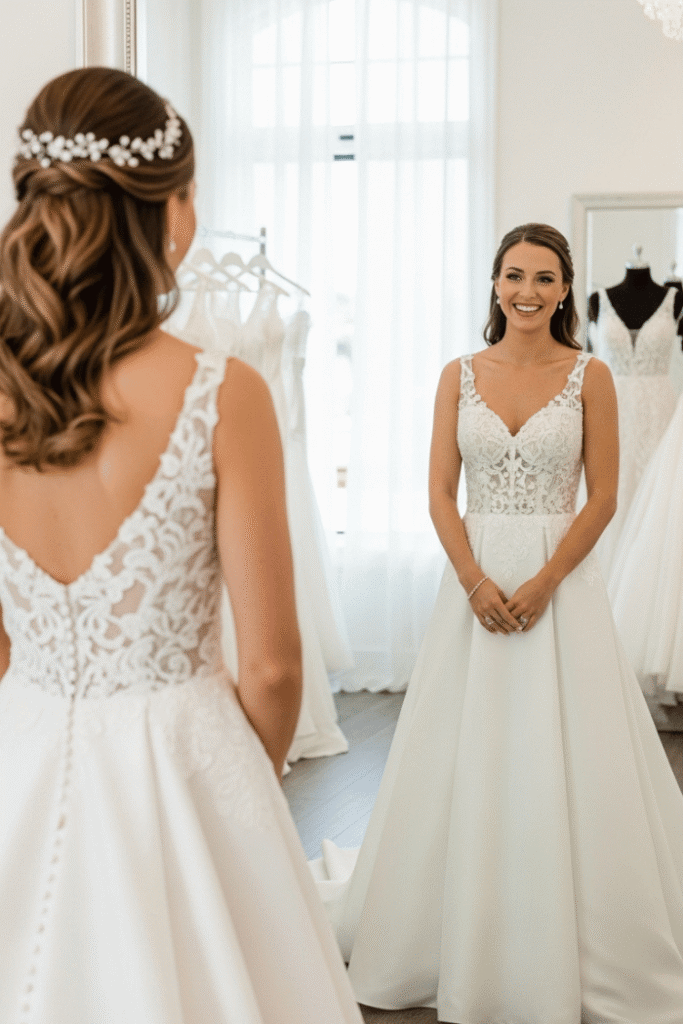
Right Dress for Petite Brides with a Small Bust
Petite brides with a smaller bust can select dresses that enhance curves or celebrate their sleek physique. Corset bodices effectively create the illusion of a fuller bust. They employ strategically placed boning to provide structure and lift. Sweetheart necklines, with their heart-like shape, further contribute to this illusion. The Millah Wedding Dress features such a corset bodice. Alternatively, a straight, strapless neckline offers a chic option. Smaller busts often require less support, making strapless styles comfortable and flattering. The Atalanta Wedding Dress, a strapless fit-and-flare, showcases this elegant approach.
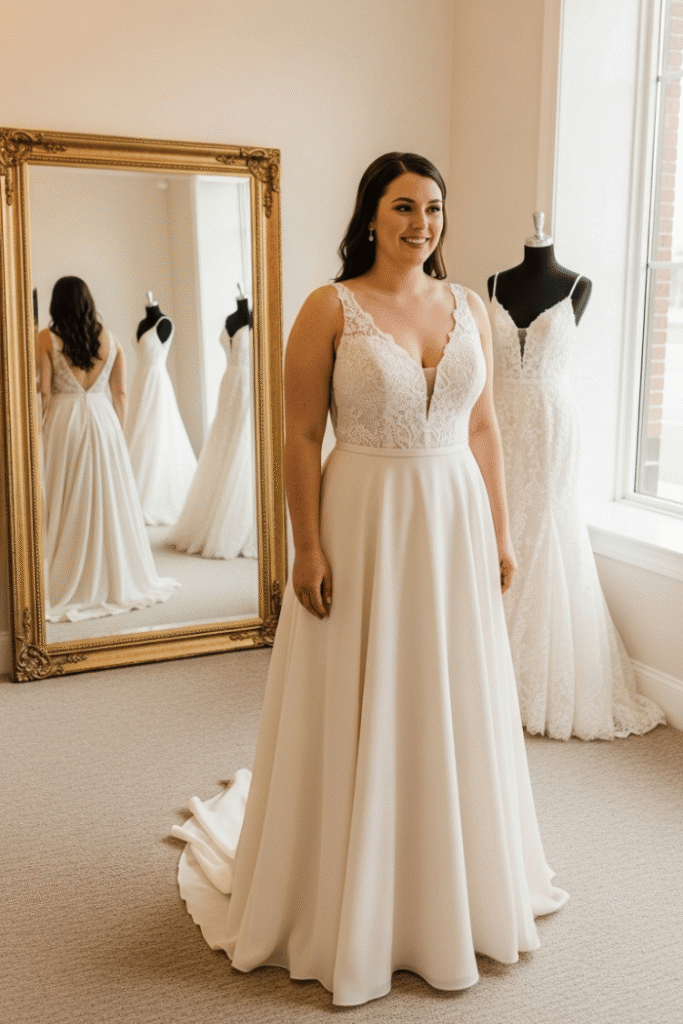
Finding the Right Dress for Petite Brides with a Big Bust
For petite brides with a larger bust, optimal support is a key priority for comfort and confidence. Gowns with straps or sleeves ensure stability, preventing constant adjustments throughout the day. Illusion necklines also provide an excellent solution. These designs feature sheer net fabric over the chest, offering coverage while maintaining a stylish, exposed skin effect. The Evangeline, Remmy, and Antheia Wedding Dresses provide examples of supportive and stylish options, ranging from delicate sheaths with widening straps to ball gowns with illusion bateau necklines.
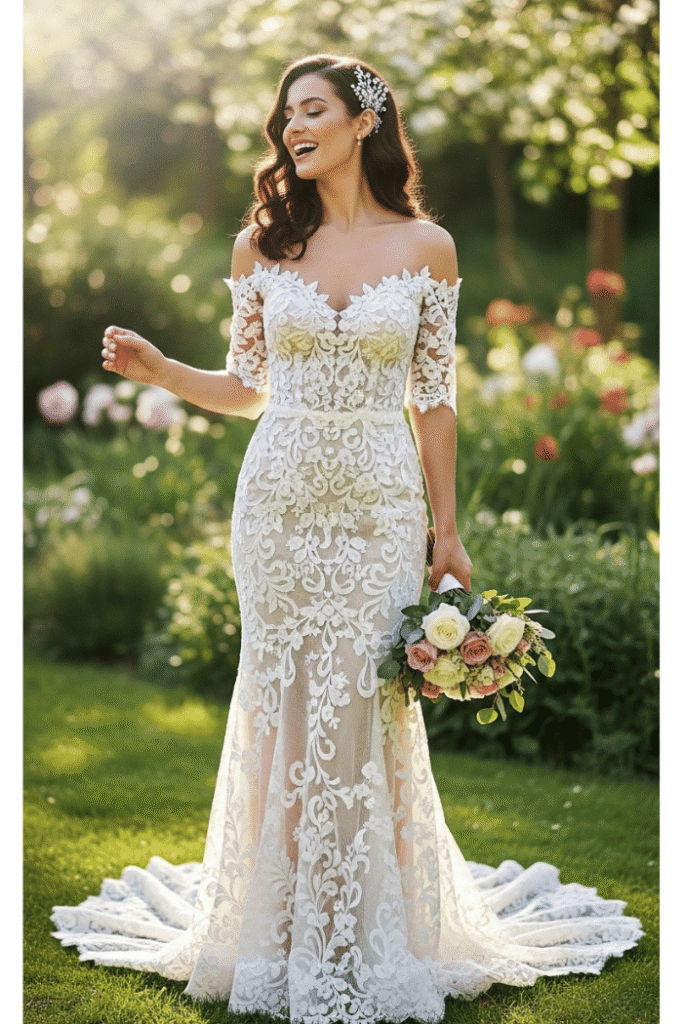
Petite Lace Wedding Dresses
Lace imbues a wedding dress with classic romantic appeal. Petite lace wedding dresses benefit from the same silhouette and design considerations as other styles. Fit-and-flare lace gowns, like the Vasiliki Wedding Dress, combine a corset bodice and plunging neckline to enhance the figure. For a more traditional, fuller look, the Speare Wedding Dress offers an Alençon lace ball gown. Its sheer, boned bodice and sweetheart neckline provide structure and detail without overwhelming a petite frame.
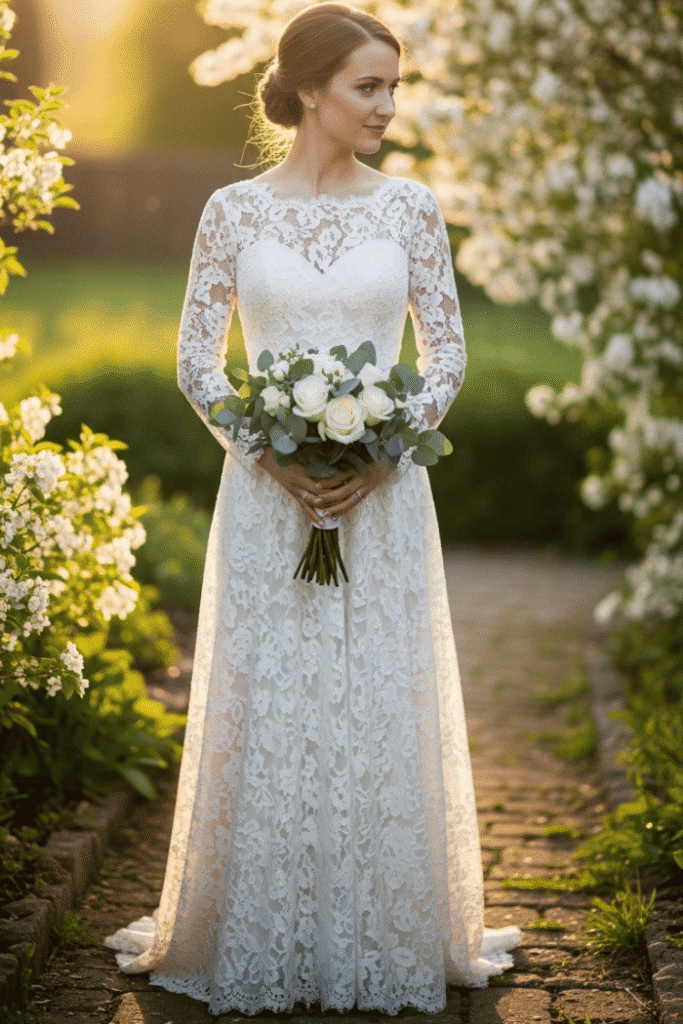
Long Sleeve Petite Wedding Dresses
Petite brides can elegantly wear long sleeves. The key lies in selecting slim-cut or illusion sleeves. These styles follow the arm’s natural line, contributing to an elongated effect. Illusion sleeves, crafted from sheer lace or tulle, offer coverage with minimal visual weight, creating a sophisticated and ethereal aesthetic. The Zoe Wedding Dress features detachable long sleeves for versatile styling, while the Savina Wedding Dress incorporates regal illusion lace sleeves into a fit-and-flare silhouette.
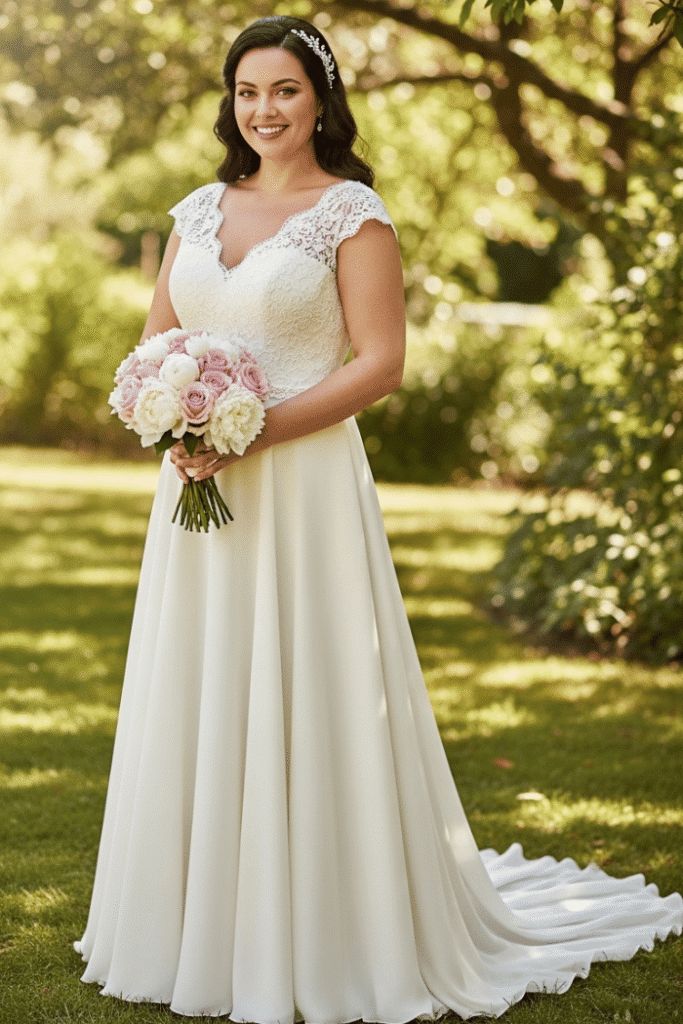
Petite Plus-Size Wedding Dresses
The term “petite” does not exclude “plus-size.” Many plus-size brides also fall within the petite height range. Their needs focus on structured fits and flattering silhouettes. The A-line and mermaid styles remain highly effective, skimming curves gracefully. According to a 2020 market analysis by Bridal Wear Today, collections specifically designed for plus-size petites achieve 92% satisfaction among brides.
Gowns with internal corsetry provide essential support and shaping. Wider straps or supportive sleeves also contribute significantly to comfort. The Silver Wedding Dress, a romantic mermaid, utilizes a plunging V-neckline and double-banded waist to elongate the body. For a classic princess feel, the Minerva Wedding Dress, an A-line gown with supportive straps and a stylized V-neckline, offers timeless elegance. The Valeria Wedding Dress provides a sexy fit-and-flare option, with a draped basque waist and unique angel wing neckline.
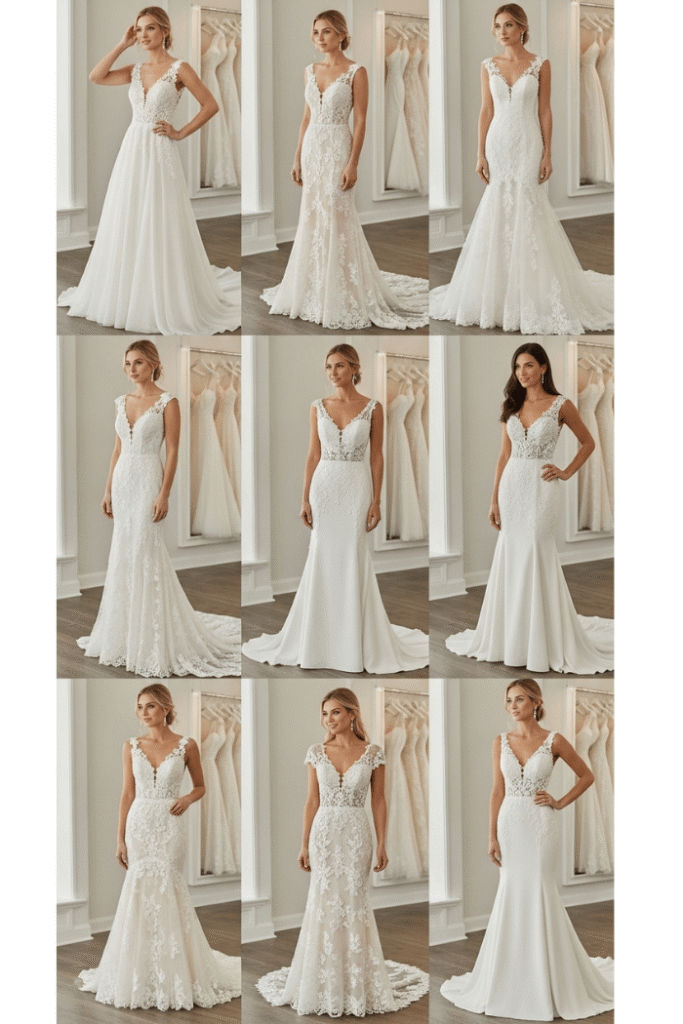
Wedding Dresses for Petite Brides with an Hourglass Figure
Petite brides with an hourglass figure aim to accentuate their natural curves. The mermaid silhouette is a prime choice for this body type. Its form-fitting design through the bodice, waist, and hips, coupled with a dramatic flare, beautifully highlights the hourglass shape. This silhouette also benefits from the vertical elongation discussed earlier. The Selene Wedding Dress exemplifies a refined mermaid gown with a clean scoop neckline and sheer side cutouts that contour the waist. For a softer interpretation, the Stassi Wedding Dress, a ruched tulle mermaid with a strapless scoop neckline and corset boning, enhances curves elegantly.
Conclusion
Petite brides possess the ability to look absolutely stunning by selecting wedding dresses with the right silhouettes, necklines, fabrics, and custom alterations. Understanding how design elements interact with a smaller frame empowers informed choices. We encourage every bride to explore diverse styles, engage in multiple fittings, and confidently embrace the unique beauty of her individual frame. The perfect wedding dress awaits, ready to make your special day unforgettable.
People Ask Questions
- Can I still wear a ball gown?
Yes—but only if design proportions are carefully managed. A huge skirt with a tight bodice might overwhelm your frame. Stylist advice tends to favor more moderate shapes like A-line or sheath for petites. - Do I have to avoid mermaid styles completely?
Not necessarily. A modified mermaid with a softer flare and minimal contrast can work. But true trumpet cuts that flare sharply at the knee often break the leg line. - Will alterations ruin the original design?
A skilled bridal tailor will maintain the dress’s aesthetic while adjusting proportions. Good salons understand petite conversions. - How much extra should I budget for alterations?
Moderately more than standard gowns, because you may need bodice shortening, seam repositioning, and hem adjustments to preserve design integrity.

Sophia Lane is a dedicated bridal fashion writer and wedding style consultant with over a decade of experience in helping brides-to-be discover their dream gowns. With a background in fashion journalism and bridal styling, Sophia specialises in writing detailed, research-driven guides on wedding dress styles, fabrics, accessories, and bridal trends.
Her work blends in-depth fashion knowledge, cultural research, and practical advice, ensuring brides receive content that is both inspiring and actionable. She has studied wedding dress history across cultures, analysed emerging eco-friendly bridal trends, and regularly collaborates with designers to stay updated on the latest collections.
Expertise
-
Wedding dress styles, fabrics, and silhouettes
-
Body-shape based bridal styling (petite, plus size, tall, maternity)
-
Sustainable and eco-friendly bridal fashion
-
Bridal accessories, tailoring, and preservation techniques
-
Global cultural wedding attire traditions




